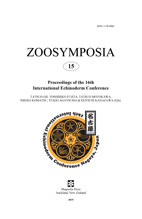Abstract
The pigment cells of some sea urchin embryos emanate autofluorescence in response to light irradiation. However, it is unclear if this feature is maintained throughout larval development. In the present study we observed embryos and larvae of the temnopleurid sea urchins Temnopleurus hardwickii, T. reevesii, T. toreumaticus and Mespilia globulus exposed to light irradiation, and compared our findings with those of a strongylocentroid, Hemicentrotus pulcherrimus. After exposure to ultraviolet irradiation for a few minutes, there was a strong signal from the temnopleurid sea urchins. The signal was detected from a cell mass that is part of the adult (juvenile) rudiment, formed during development of the prism to the two-armed larval stage and not from pigment cells. This signal was observed in both live and formalin-fixed specimens. Fluorescence was also detected from the digestive organs, coelomic pouches, the ciliary band on the oral hood, from some yellowish-green cells and ectodermal cells, although there were some differences among species. In live H. pulcherrimus larvae, the amniotic cavity that is part of the adult rudiment emanated autofluorescence in response to ultraviolet irradiation. These results indicate that the autofluorescence observed in the cell mass of temnopleurid sea urchins is caused by a different mechanism than previously described. This feature may be a useful marker to trace development of the cell mass.

